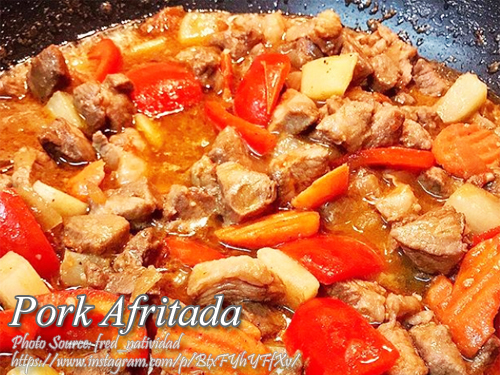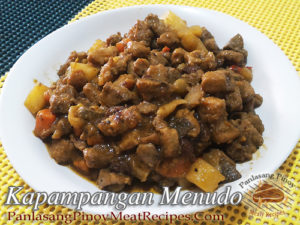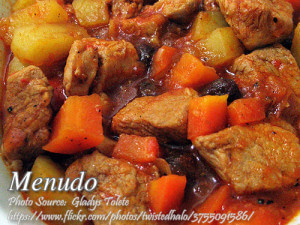Pork afritada is a pork version of the well known chicken afritada. This is a very budget friendly dish because it has few and low cost ingredients such as pork, potatoes and carrots. It is also easy to make, and you only need a single pan to do the cooking. And with regard to the taste, you will find it tasty and filling because of the tomato based sauce like your favorite menudo or mechado. Although this dish resemble to menudo in ingredients and the cooking method, pork afritada ingredients are cut twice bigger than menudo.
Pork Afritada: A Nostalgic Dish Worth Revisiting
Growing up, Sunday lunch at our home in Laguna was always a lively affair. Lola Clara, with her colorful apron tied neatly around her waist, would call everyone to the table. In the center, steaming and fragrant, was a heaping serving of pork afritada. It was her way of bringing the family together, and this humble tomato-based stew quickly became a household favorite. Today, I’m sharing her recipe with a little twist—small adjustments I’ve learned over the years to make this dish even more flavorful and satisfying.
What Makes Pork Afritada Special?
Pork afritada is one of those dishes that perfectly balances comfort and practicality. While it’s similar to menudo or mechado, afritada stands out because of its slightly larger cuts of meat and vegetables, giving each bite a hearty and satisfying texture. The tomato-based sauce, rich and savory, makes it a perfect partner to steaming white rice.
What I love most about the dish is its versatility. It uses affordable ingredients like pork shoulder, potatoes, and carrots, yet it delivers a dish that’s both filling and delicious. It’s the kind of meal you can prepare on a budget without sacrificing flavor—a quality that makes it a staple in many Filipino households.
Tips and Techniques for Perfect Pork Afritada
One of the secrets to a flavorful afritada lies in frying the vegetables before adding them to the stew. My Tita Belen always emphasized this step, explaining that frying gives the potatoes and carrots a firmer texture, preventing them from turning mushy during cooking. Plus, the light caramelization enhances their natural sweetness, adding depth to the dish.
Sauteing the bell peppers separately is another technique I picked up from Kuya Jojo, who worked as a cook in a small eatery in Batangas. By giving the peppers a quick toss in hot oil before adding them at the end of the cooking process, you retain their vibrant color and subtle crunch. It’s a small detail, but it makes a world of difference in the final presentation and flavor.
A Rich Tomato Sauce That Ties It All Together
The tomato sauce is the heart of the dish, and getting it just right is essential. I’ve found that a combination of canned tomato sauce and fresh water strikes the perfect balance between tangy and savory. Adding a pork bouillon cube enhances the sauce, creating a rich, meaty flavor that clings beautifully to the chunks of pork and vegetables.
When cooking the pork, patience is key. Letting it simmer slowly in the sauce ensures that the meat becomes tender and fully infused with flavor. This step might take a bit longer, but trust me, it’s worth it. My uncle Pedro used to say, “Afritada is a dish of love—you can’t rush it.”
The History Behind Pork Afritada
Pork afritada has its roots in Spanish cuisine, as the word “afritada” comes from the Spanish word fritada, which means “fried.” This reflects the initial step of frying the meat and vegetables before combining them into a stew. Over the years, Filipino cooks have adapted the recipe to suit local ingredients and preferences, turning it into the beloved dish we know today.
Interestingly, afritada wasn’t always made with pork. Chicken afritada is a more common variant, but using pork became popular due to its affordability and availability in the Philippines. Families in farming communities often raised pigs, making pork a natural choice for hearty meals like this one.
Bringing It All Together
Cooking pork afritada is as much about the process as it is about the ingredients. Start by frying the potatoes and carrots until golden brown, then set them aside. This step ensures they’ll hold their shape when simmered later. Next, saute the garlic and onions in the same pan to build a flavorful base before adding the pork. Once the pork is lightly browned, a splash of fish sauce adds that quintessential umami kick.
The tomato sauce and water come next, followed by a pork cube for an extra layer of flavor. Let everything simmer gently, giving the pork time to tenderize and absorb the rich tomato essence. When the meat is nearly done, toss in the fried vegetables and let the stew thicken until it reaches your desired consistency. Finally, add the sauteed bell peppers just before serving for that pop of color and crunch.
Serving and Enjoying Pork Afritada
There’s nothing quite like the sight of pork afritada being served fresh from the pot. The rich, red sauce glistens as it coats the tender pork and perfectly cooked vegetables. Pair it with a steaming bowl of white rice, and you have a meal that feels like a warm hug from home.
For me, it isn’t just a dish; it’s a reminder of family gatherings, shared laughter, and the comforting taste of home-cooked meals. Whether you’re making this dish for the first time or revisiting a childhood favorite, I hope it brings the same warmth to your table as it does to mine.
Cooking it might take some time, but as Lola Clara always said, “The best meals are the ones made with care.” So grab your ingredients, put on your favorite music, and let this classic Filipino dish bring a bit of nostalgia—and a lot of flavor—into your kitchen.
How to Cook Pork Afritada
Ingredients
- 1 kilo pork belly or pork kasim sliced into serving pieces
- 2 pc medium sized potatoes quartered
- 1 pc medium red bell pepper quartered
- 1 pc medium green bell pepper quartered
- 1 pc medium onion chopped
- 3 cloves garlic minced
- 1 cup tomato sauce
- 1 1/4 cup water
- 1 pc pork bouillon or pork cube
- 1/2 Tbsp fish sauce
- salt and pepper to taste
- cooking oil
Instructions
How to cook Pork Afritada:
- Heat cooking oil in a pan about 4 tablespoons. Fry the potatoes and carrots until slightly brown. Drain and set aside.
- In the same pan, saute the bell peppers for about half a minute then remove from the pan and drain. Set aside.
- In the same pan, leaving about 2 tablespoon of cooking oil, saute garlic & onion.
- Add the pork and saute for a minute or until lightly brown. Add the fish sauce and cook for 1 minute.
- Add tomato sauce and water and bring to a boil then add the pork cube. Cover and simmer for 45 minutes or until tender.
- Add the potatoes and carrots. Simmer until are tender and the sauce is thickened.
- Add the bell pepper and simmer for a minute or two. Season with salt and pepper to taste.
- Remove from heat and transfer to a serving bowl. Serve with hot steamed rice.
Video
Notes
Cooking Tips:
Fry the Vegetables for Better Texture and Flavor
Frying the potatoes and carrots before adding them to the stew ensures they keep their shape and don’t become overly soft during cooking. This step also enhances their natural sweetness through caramelization, adding depth to the dish. It’s a small effort that makes a big difference in the overall flavor and texture of your dish.Saute the Garlic and Onions First for a Flavorful Base
Always begin by sauteing garlic and onions in hot oil to build a flavorful base for the dish. The garlic adds a warm, aromatic note, while the onions bring a hint of sweetness that balances the tanginess of the tomato sauce. This simple technique creates a robust foundation for the rich, savory sauce.Simmer Slowly for Tender Pork and Flavorful Sauce
Let the pork simmer gently in the tomato sauce for the best results. Slow cooking allows the meat to tenderize and fully absorb the flavors of the sauce, creating a melt-in-your-mouth texture. This method also helps thicken the sauce naturally, making it rich and velvety without the need for additional thickeners.





